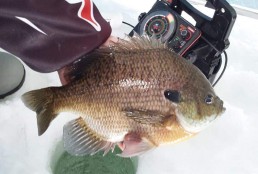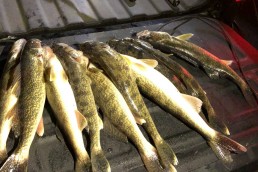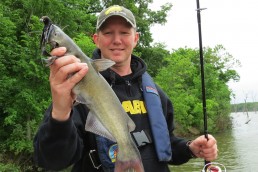Early-season Bluegills are Prime for Catchin’ and Eatin’
SHARE THIS POST
About this time of year in many areas of the Upper Midwest, the thoughts of many anglers turn to catching eating-sized bluegills. The bantam-sized brawlers that have not been harvested by the industrious ice fishermen are already developing egg sacks in their bodies, and in a matter of a few months may even be on the spawning beds.
For those of us who love not only to catch these colorful little fish, but also dine upon their succulent flesh, there is no better time than now to catch them. In the chilly winter or late-spring waters, their flesh is firm and offers some of the best eating of the year.
Even though the water is cold, the fish will bite and can be caught if a few basic rules are followed. Bluegills now have just three instincts that guide their lives: to eat, to survive and to reproduce. Begin your search for them in somewhat deeper water than you would later in the spring season. At this time of year they will “stage” just off of breaklines that are adjacent to feeding and spawning flats that drop off into deeper water. Bear in mind, bluegills are schooling fish. When you find a couple, you probably will find several more.
There is no better rule of thumb for early spring than to present the fish with live bait, i.e., red worms, waxworms or maggots, or with something that looks, acts and smells like the real thing. And yes, they will hit just about anything when they put on the feedbag. I have taken them on topwater lures, spinnerbaits, crankbaits, jigs and even on 6-inch, Texas-rigged worms.
But to keep it simple, my preference is to impale a live worm or a Gulp grub on a small hook dangled below a round bobber, make the cast and watch for a bite. The keys to success here are to first to know where to make the cast, and second, know what depth to fish.
Are you enjoying this post?
You can be among the first to get the latest info on where to go, what to use and how to use it!
Look for sunken brush piles in farm ponds, downed trees in rivers and lakes, or for overhanging brush over deep-water breaks. In the early part of the day when the water begins to warm, the fish will leave their deep-water haunts and cruise up onto the flats to feed. Many of these flats will be the same areas where they will spawn. Cast close to any existing structure and let the fish tell you how deep to set your bait. Start at 18 inches; if there are no bites, go to 24 inches. No bites still? Go deeper. Then try going shallower if nothing hits there. Vary your offerings until the fish begin to bite. The chances are very good fish will be at the same depth in various parts of the lake.
Now, for the best part: I like to eat bluegills, but I don’t like a lot of fuss and bother when I do. So, the bigger fish are filleted for the skillet. No fuss; no bother. If the fish are smaller—the 5- to 7-inch range—they are scaled, gutted and the sharp spines are removed. For this, first cut parallel to both sides of the dorsal and anal fins with a sharp filet knife, and then rip forward and out from the base of the spines with a pair of needle-nosed pliers. This makes for a very nice portion that will be rinsed, soaked in light saltwater, rinsed again, patted dry, and finally dipped in a mixture of beaten eggs and milk and rolled in a mixture of flour and corn meal.
I make a fire in the pit in my backyard, ignited by the old method of flint, steel and tinder. After adding some chunks of dried hardwood, the fire is allowed to burn down to glowing coals, just right for cooking.
Then get an old, black skillet. Any type of oil will do, but I prefer either canola or peanut oil for the best flavor. Heated the oil over the fire until it is hot, but not smoking. Dust your fish with a bit of Mrs. Dash’s seasoned salt and lower it into the oil. I give them just enough time to be cooked through so the fish are golden brown and crispy.
There are few greater joys in life than sitting under a tree in the yard and dining upon freshly fried bluegills. Add a crisp garden salad and some apple slices and you have a meal fit for a king.
MWO
SHARE THIS POST
Did you enjoy this post?
You can be among the first to get the latest info on where to go, what to use and how to use it!
John Bennett
John Bennett is a retired history teacher, historical re-enactor, father and grandfather. As a four-season outdoorsman, his passion is waterfowl hunting and fishing for smallmouth bass. He lives in Ohio and spends quite a bit of time in his primitive log cabin, which he built.



